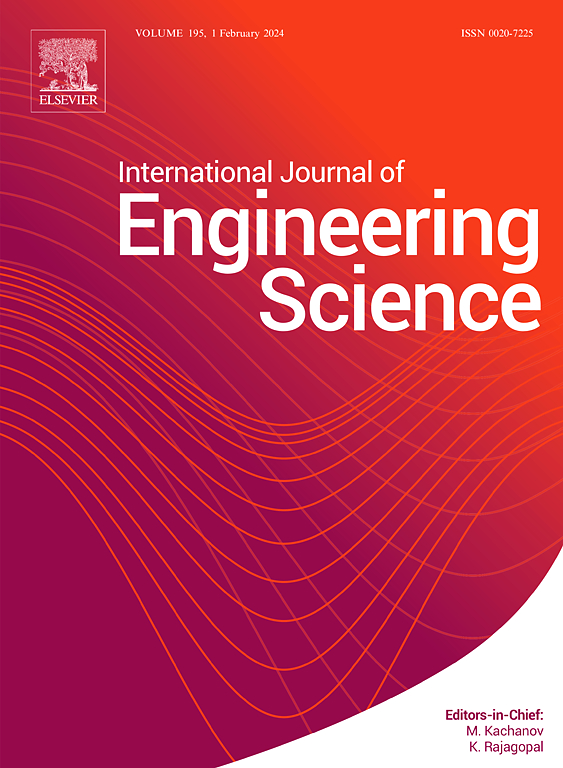Dynamical homogenization of microstructured media towards micromorphic effective continua
IF 5.7
1区 工程技术
Q1 ENGINEERING, MULTIDISCIPLINARY
International Journal of Engineering Science
Pub Date : 2025-03-26
DOI:10.1016/j.ijengsci.2025.104255
引用次数: 0
Abstract
The virtual power principle for materials with microstructure modeled in the framework of micromorphic effective media is written from a micromechanical perspective, considering recent contributions of (Alavi et al., 2021, 2023) however restricting to statics. In the present work, we extend the micromorphic framework to dynamics by deriving the macroscopic kinetic energy from the upscaling of microscopic classical principles. Our methodology focuses on identifying a homogeneous velocity that captures the microscale kinematics of the micromorphic effective medium, defined by the macroscopic velocity and the rates of the displacement gradient, distortion tensor, and its first gradient. Unit cell boundary value problems are formulated for the velocity fluctuation that leads to the computation of the effective dynamical micromorphic properties. The predictions of kinetic energy, incorporating higher-order contributions, are exemplified by the square and tetrachiral unit cells, emphasizing the crucial role of structural design in micromorphic media. Internal length scales, comparable to the unit cell size, further validate the micromorphic model's capability to capture scale-dependent effects and demonstrate its effectiveness in predicting the dynamic behavior of architected materials.
微观结构介质向微形态有效连续体的动态均匀化
考虑到(Alavi et al., 2021, 2023)最近的贡献,在微形态有效介质框架中模拟微观结构的材料的虚功率原理是从微观力学的角度编写的,但仅限于静力学。在本工作中,我们通过从微观经典原理的上尺度推导宏观动能,将微态框架扩展到动力学。我们的方法侧重于确定一个均匀速度,该速度捕获微观有效介质的微观运动学,由宏观速度和位移梯度、畸变张量及其第一梯度的速率定义。对速度波动问题提出了单元胞边值问题,从而计算出有效的动力学微态性质。结合高阶贡献的动能预测,以方形和四手性单位细胞为例,强调了结构设计在微形态介质中的关键作用。内部长度尺度,与单元尺寸相当,进一步验证了微形态模型捕捉尺度依赖效应的能力,并证明了其在预测建筑材料动态行为方面的有效性。
本文章由计算机程序翻译,如有差异,请以英文原文为准。
求助全文
约1分钟内获得全文
求助全文
来源期刊

International Journal of Engineering Science
工程技术-工程:综合
CiteScore
11.80
自引率
16.70%
发文量
86
审稿时长
45 days
期刊介绍:
The International Journal of Engineering Science is not limited to a specific aspect of science and engineering but is instead devoted to a wide range of subfields in the engineering sciences. While it encourages a broad spectrum of contribution in the engineering sciences, its core interest lies in issues concerning material modeling and response. Articles of interdisciplinary nature are particularly welcome.
The primary goal of the new editors is to maintain high quality of publications. There will be a commitment to expediting the time taken for the publication of the papers. The articles that are sent for reviews will have names of the authors deleted with a view towards enhancing the objectivity and fairness of the review process.
Articles that are devoted to the purely mathematical aspects without a discussion of the physical implications of the results or the consideration of specific examples are discouraged. Articles concerning material science should not be limited merely to a description and recording of observations but should contain theoretical or quantitative discussion of the results.
 求助内容:
求助内容: 应助结果提醒方式:
应助结果提醒方式:


